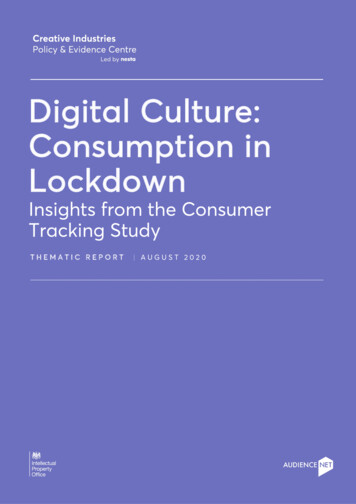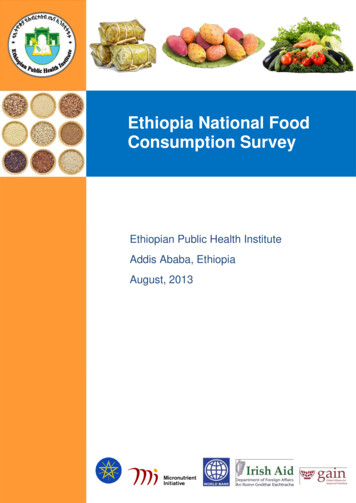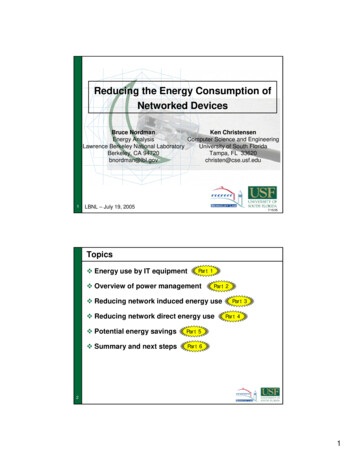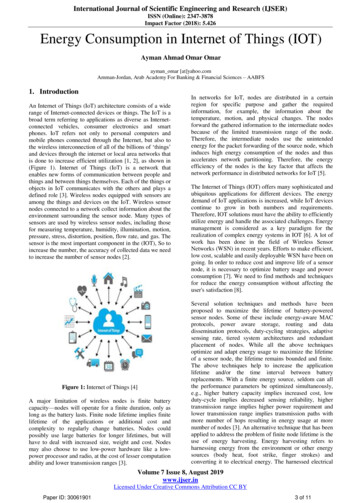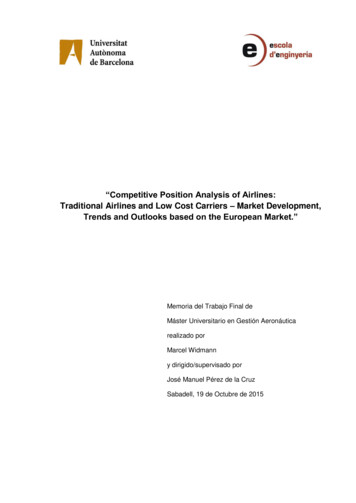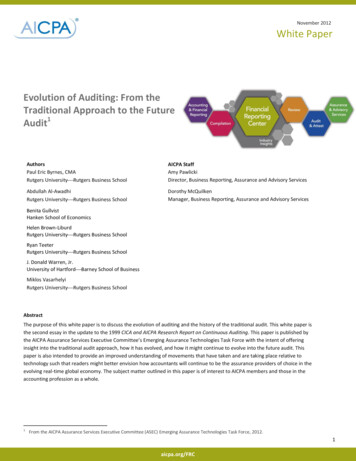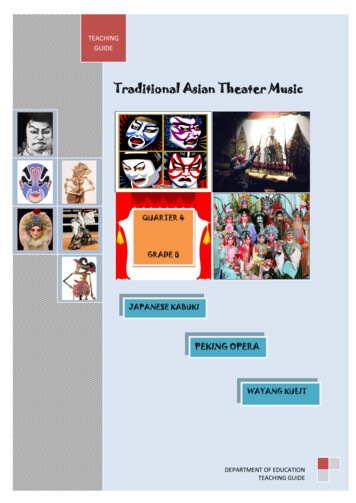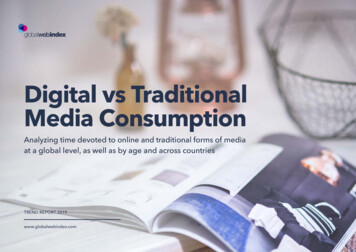
Transcription
Digital vs TraditionalMedia ConsumptionAnalyzing time devoted to online and traditional forms of mediaat a global level, as well as by age and across countriesTREND REPORT 2019www.globalwebindex.com
ContentsIntroductionDefinitions 03Key stats and trends 04Global trends in media consumption 05Media consumption by age 14National differences in media consumption 20Traditional vs digital: TV, radio and press 28Notes on methodology 38More from GlobalWebIndex 40The shift from traditional to digital mediais much discussed but rarely quantified.In this report, GlobalWebIndex offers aunique perspective on day-to-day mediaconsumption behaviors by age andacross 41 markets – analyzing how muchtime people are spending online, trackingthe types of media they are consumingand assessing the share of time spenton digital versus traditional forms oftelevision and print press.
DefinitionsIn this report, we draw on our cross-mediaconsumption questions which ask internetusers to estimate how much daily time theytypically devote to the following activities: INTERNET USAGEVia PC/laptop/tabletVia castOnline Radio/Music StreamingPRESSTraditional Print Press/NewsOnline Press/NewsSOCIAL NETWORKS/SERVICESGAMES CONSOLESAs a result, all figures referring to time spent onthese activities are based upon self-reportedestimates and the following definitions:LINEAR TV: Television that is traditionallybroadcast and watched in real-time.ONLINE TV/STREAMING: Television that isstreamed online or watched on-demand. Thisincludes usage of catch-up services like BBCiPlayer and TV streaming services like Netflix.BROADCAST RADIO: Radio channels that aretraditionally aired and listened to in real-time.MUSIC STREAMING SERVICES: Radiochannels that are listened to online, typicallyvia streaming.TRADITIONAL PRINT PRESS: Physical,printed forms of press, e.g. newspapers andmagazines.ONLINE PRESS: Press or news stories that areread online e.g. via news websites or apps.We use this data to calculate averageamounts of time spent on each activityper day from 2014 to 2018. To do this, weassign a number of minutes to each periodof time (as shown below), multiply thisby the relevant universe figure and thencalculate the average.This generates easily comparable data whichenables us to estimate total time spentacross markets or consumer segments.Less than 30 minutes 0.25 hours30 mins to 1 hour 0.75 hours1 to 2 hours 1.5 hours2 to 3 hours 2.5 hours3 to 4 hours 3.5 hours4 to 6 hours 5 hours6 to 10 hours 8 hoursMore than 10 hours 10 hoursDo not use 0 hours
Key stats and trendsOn a typical day, internet users estimate thatthey spend 6 ¾ hours online. Smartphonesare becoming ever more prominent withinthis: since 2016 estimated daily time spentonline on mobiles has jumped from 2.5 hoursto more than 3 ¼. Overall time spent onlineincreased steadily from 2012 to 2017, but hassince stagnated as the increase in time onmobile units has failed to fully offset the loss intime spent on larger screen units. We may beapproaching a saturation point.Age has a big impact on daily time spentonline. 16-24s report being online for almostthree hours longer per day than 55-64s. Theyoungest consumers’ enthusiasm for mobilesaccounts for the difference. These devicesnow account 55% of their total internet time(compared to just a third for 55-64s). It’s forthis reason that we see 16-24s ahead for onlinemedia activities like social networking andonline TV.We’re past the mobile-tipping point. Onlyin Japan do consumers spend longer ontraditional rather than digital forms of media.Age is the main factor: markets where digitalmedia account for the lowest shares of timespent are mature markets with high internetpenetration and older online populations.Time spent watching linear TV has declinedin 31 out of 32 countries tracked since 2014,increasing only in China, Japan, Turkey andSouth Korea (by 6-3 minutes). Music streamingin 2018 commands more time than onlineradio did in 2014 in every market tracked,and broadcast radio is down in 24 out of 32markets. Print press declined in 24 out of 32markets while online press increased in 26.Daily time spent on social networks/servicescontinues to increase. Digital consumerswere spending 39 minutes longer on socialnetworks in 2018 than they were in 2014.16-24s and those in fast-growth markets arethe most enthusiastic social networkers, butsocial networks are capturing more time acrossall the age groups and markets.Traditional forms of media are not beingabandoned, though. Despite constant claimsthat the internet is taking people awayfrom other media formats, most are actuallyholding their own. Linear TV remains aheadof online TV in all markets and represents thesingle biggest daily media activity after socialmedia. Similarly, broadcast radio remainsahead in the vast majority of markets. Thesituation is rather different for press, though:here, online is ahead of print editions in all buttwo markets.Second-screening is prolific: over 85% useanother device as they watch television. Whilesocializing with friends and family throughsocial media and messaging services is themost common simultaneous activity, some8 in 10 also read news and play games.Encouragingly for marketers, very large sharesalso research the products they see on TV,which strengthens the notion that secondscreening is more of a complement than acompetitor to TV advertising.
Global trends in media consumptionTracking media consumption behaviors from 2014-2018KEY FIGURES D igital consumers are now spending 6 ¾ hours per dayonline, with 3:18 hours of this time – 51% – spent onlinevia mobiles (up from 1 hour 17 mins in 2014). O nline TV has exceeded an hour per day, but linear TVis holding steady at just under 2 hours. 2 :20 hours a day go on social media, accounting for thebiggest share of online media time (35%). W ith over 85% second-screening as they watch TV,simultaneous multi-media consumption is now thenorm. Mobiles are the clear device of choice here.DIGITAL VS TRADITIONAL MEDIA CONSUMPTION TREND REPORT
Daily media timeGLOBAL TRENDS INMEDIA CONSUMPTIONOn a typical day, internet users estimate that they are now spending an averageof 6 ¾ hours online. This means that they’re spending longer online than they areon linear TV, broadcast radio, games consoles and print press combined.Media consumption behaviorsOnline media behaviorsNumber of hours and minutes per daytypically devoted to the followingNumber of hours and minutes per daytypically devoted to the following06That linear TV composes such a considerablechunk of this daily media time is testament tothis form of entertainment still retaining a centralrole within daily media portfolios. The averageconsumer tunes in for 1 hour and 55 minuteseach day, meaning that TV still accounts for closeto a fifth of daily media time.Of the time devoted to specific online mediaactivities, social networks and messaging servicesare by far the most popular. They capture wellover 2 hours each day, accounting for more than athird of time spent online.Online TV/streaming has now passed the 1 hourper day mark. It reaches even higher among the25-34-year old internet users and those in somefast-growth markets, which we often see withdigital media, but in this case strong popularity inNorth America is boosting time spent. Globally,though, it still has some distance to cover beforeit can become a real challenger to traditionalbroadcast TV. Linear TV is still an hour ahead inaverage daily viewer time.Online TV is racing ahead. In 2016, a fifth ofinternet users globally said they’d used Netflix inthe past month. In 2017, it was over a quarter. In2018, almost two-fifths (38%.)Question: Roughly how manyhours do you spend on/doingthe following each day?Source: GlobalWebIndex 2018Base: 391,130 Internet Usersaged 16-64
Daily media timeGLOBAL TRENDS INMEDIA CONSUMPTION07Media behaviorsNumber of hours and minutes per day typically devoted to the followingTOTAL16 2425 3435 4445 5455 64APACEUROPELAT AMMEANORTH AMOnline via 903:3104:2204:0703:59Online 803:5902:28Social 03:0502:03Linear 5602:51Music Streaming :2401:1501:26Online 1201:18Games :0101:0601:05Online 01:1200:48Broadcast 01:0201:13Physical Print 00:4200:35We expect figures for online TV to continue toincrease. In the context of streaming devices, mirroringand other similar behaviors, maintaining a harddistinction between linear vs online TV/streaming isbecoming increasingly anachronistic.Elsewhere, time spent reading online press has gone from 50 minutes in 2016 to 59in 2018. Music streaming has increased dramatically in the time it has been tracked,and now accounted for 1:14 hours – even as methodology changed from trackingonline radios in general to only music streaming. While online radio still lags itsbroadcast counterpart, online news coverage is ahead of traditional print press.Question: Roughly how manyhours do you spend on/doingthe following each day?Source: GlobalWebIndex 2018Base: 391,130 Internet Usersaged 16-64
Daily media timeGLOBAL TRENDS INMEDIA CONSUMPTION08Share of daily time online by deviceNumber of hours and minutes per day typically devoted to the following* Bigger screen refers toPCs, laptops or tabletsQuestion: Roughly how manyhours do you spend on/doingthe following each day?Source: GlobalWebIndex 2018Base: 391,130 Internet Usersaged 16-64
Media consumption: Online & offlineGLOBAL TRENDS INMEDIA CONSUMPTION09Daily media time: All activitiesNumber of hours and minutes per day typically devoted to the followingWhen online and offline activities are examinedin tandem, it’s clear just how much influence TVstill exerts over daily activities, as well as just howquickly social networking has established itself asa mainstream behavior. Taken together, these twoactivities account for well over 4 hours and close to40% of media portfolios.Arguably just as important is that physical print pressremains at the bottom of the list, behind all onlineforms of media, despite creeping up a few minutes.Question: Roughly how manyhours do you spend on/doingthe following each day?Source: GlobalWebIndex 2018Base: 391,130 Internet Usersaged 16-64
Digital vs traditional media over timeGLOBAL TRENDS INMEDIA CONSUMPTIONDigital vs traditional over timeTime spent online: PCs/laptops/tablets vs mobilesNumber of hh:mm per day typically devoted to the followingNumber of hh:mm typically spent online via the following devices each dayLooking at the battle of digital andtraditional media over time yields someinteresting results. Each year, internetusers are spending consistently longer ondigital media – now devoting 28 minutes onaverage to the media we track.Linear TV lost 13 minutes compared to2014. Broadcast radio gained 1 minute;print, just 4. So there is no across-the-boardcollapse, at least not on the global level,but the growth in media consumptionhappening globally is going into digital.Except for linear TV, they’re similar to wherethey were in 2012.That’s a key point to note and one which willrecur throughout this report: despite frequentclaims that the internet is taking peopleaway from other media formats, most areholding their own. The fact that behaviorssuch as second-screening are causing manyactivities to happen simultaneously rather thansequentially is central to this.Overall increases in internet consumptionare thus being driven by progressivelyheavier usage of mobiles – devices whichhave jumped from just 1 hour 17 minutesback in 2012 to 3 hours, 18 minutes in 2018.We began to observe a drop in time spentonline via PCs, laptops, and tablets in 2016,which has continued.Since tracking began in 2012, we've seensteady, year-on-year increases in the amountof time spent on mobile. The long-expectedtipping point where mobile units overtakebigger-screen devices in time spent online islikely to be no more than a year away.As we outline in subsequent chapters,it’s fast-growth markets and youngerdemographics which are at the forefrontof this. Even so, the rise of mobile internetusage is a trend which transcends allmarkets and segments.10Question: Roughly how manyhours do you spend on/doingthe following each day? //Roughly how many hours doyou spend online on a PC/Tablet/Laptop or mobileduring a typical day?Source: GlobalWebIndex2012 2018 (averages across allwaves of research conductedin each year) Base: 1,489,506Internet Users aged 16-64
Digital vs traditional media over timeOnline media consumption behaviors: 2014 vs 2018Number of hh:mm per day typically devoted to the followingGLOBAL TRENDS INMEDIA CONSUMPTION11Since 2012, all of the specific online activities haveseen increases in terms of the daily time devoted tothem – 15% since 2016 alone.The rate of change is accelerating. Not because ofdrops in traditional consumption, but the steepeningof increases in digital media consumption. That doesnot mean that digital media are the be all and end allof media: depending on market or demographic, thatnotion would be premature. With second-screening anda blurring line between linear and online TV, for instance,we’d expect the real-life impact of these transitions tosoften as traditional players adapt.Offline media consumptions behaviors: 2014 vs 2018Number of hh:mm per day typically devoted to the followingSocial networks/services set themselves apart here,capturing an additional 39 minutes per day since 2014.Crises of faith in social media, changes away
South Korea (by 6-3 minutes). Music streaming in 2018 commands more time than online radio did in 2014 in every market tracked, and broadcast radio is down in 24 out of 32 markets. Print press declined in 24 out of 32 markets while online press increased in 26. Daily time spent on social networks/services continues to increase. Digital consumers were spending 39 minutes longer on social .
